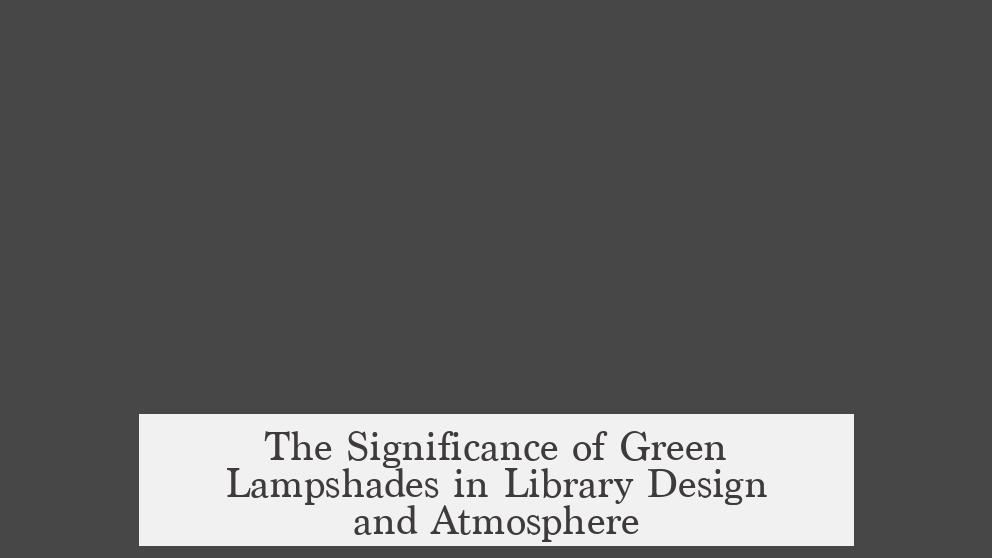Green lampshades in libraries are used primarily for effective task lighting, reducing glare, and creating an iconic atmosphere that supports reading and scholarly work.
Green lampshades, commonly found on banker’s lamps, are a hallmark in libraries such as the Boston Public Library, the French National Library in Paris, and the Royal Library of Copenhagen. These lamps feature a brass stand, a green glass shade, and a pull-chain switch. Their design dates back to the turn of the 20th century, a period when electric lighting began replacing older forms of illumination in such institutions.
The prime reason for using green shades is practical. Incandescent bulbs emit light in all directions, which can cause glare or distracting brightness in peripheral vision. The green glass shades filter this light, softening it and directing it downward onto reading surfaces. This limits harsh reflections and prevents readers from being momentarily blinded or distracted by bright light entering their view.
This focused lighting creates an ideal task light, which supports detailed work like reading, studying, or paperwork. By controlling where the light shines, the lamps facilitate concentration, essential in libraries. Despite common belief, the green color itself does not scientifically reduce eye strain, although it has been culturally regarded as a soothing color. The green shades are often open at the bottom, ensuring the table or desk receives bright, white light crucial for clarity, while the green hue absorbs harsh peripheral illumination.
Banker’s lamps gained popularity not only because of their function but also due to their visual appeal. Their soft green glow and polished brass stands add a touch of elegance and tradition. Over time, green lamps have become symbols of intellectual pursuits and scholarly endeavors, lending a historic and stately air to library interiors.
Historically, the association of green colors with calmness is partly rooted in cultural perceptions. For instance, green rooms for actors were intended as restful spaces. The lamp’s green shade connects loosely with this idea of restfulness but does not have a scientifically proven effect on vision or eye fatigue. Yet, it is a popular choice partly because the particular shade of green is pleasant to the eye and complements wood and leather furniture often found in libraries.
Another historical insight comes from Isidore of Seville’s writings in the “Etymologies,” where green marble was said to refresh weary eyes when used in library paneling. This may have influenced the tradition of using green in library design, though it directly applies to marble rather than lampshades. Still, it suggests a longstanding symbolic link between the color green and mental restoration.
The exclusive production of the green glass shades by H.G. McFaddin & Company and J. Schreiber & Neffen ensured that the style was unique and maintained high quality. This exclusivity helped the green banker’s lamp spread worldwide, becoming an enduring icon of library aesthetics and efficient lighting.
Modern libraries, however, often move away from individual task lamps for energy efficiency reasons. With large numbers of lamps, turning them off and on is logistically challenging. Instead, newer lighting systems broadcast uniform light across the space. Yet many older or prestigious libraries keep banker’s lamps as part of their heritage and ambiance.
- Green lampshades in libraries are mainly for task lighting that reduces glare by filtering light.
- The green glass directs light downward for focused illumination on reading areas.
- Green color is culturally considered soothing but lacks proven scientific benefit on eye strain.
- Banker’s lamps’ classic design with a brass stand makes them visually appealing and symbolic of scholarship.
- The style dates to early electric lighting and remains popular in traditional libraries worldwide.
- Exclusive production and marketing emphasized comfort and productivity in desk lighting.
- Modern energy concerns have reduced use of individual task lamps in newer libraries.
Overall, green lampshades in libraries combine practical lighting functions with aesthetic and symbolic significance, creating a unique environment that supports focused reading and evokes a sense of tradition.



